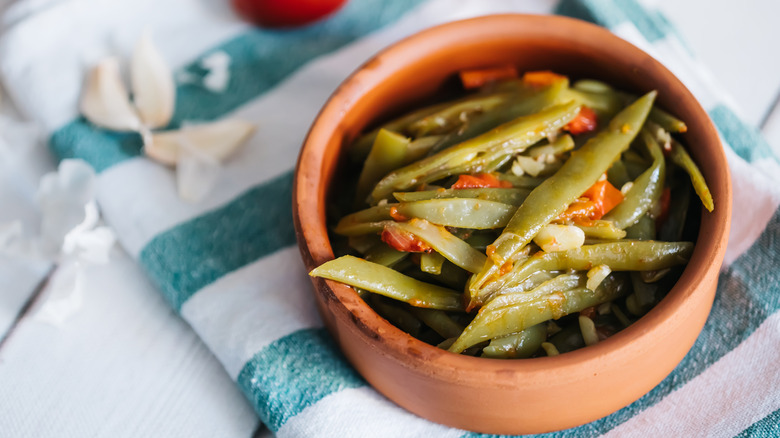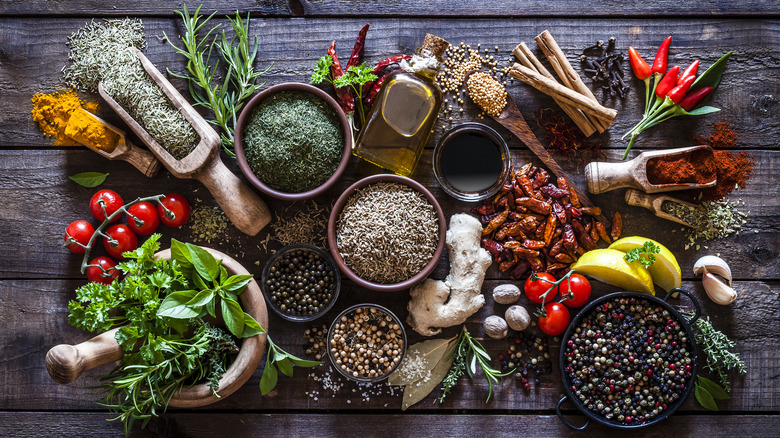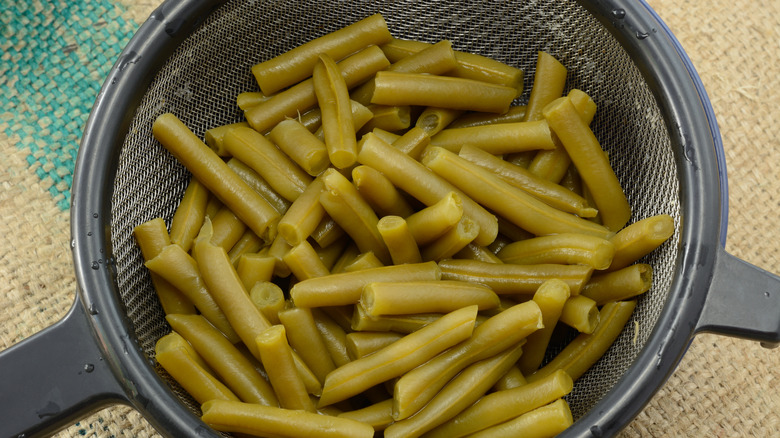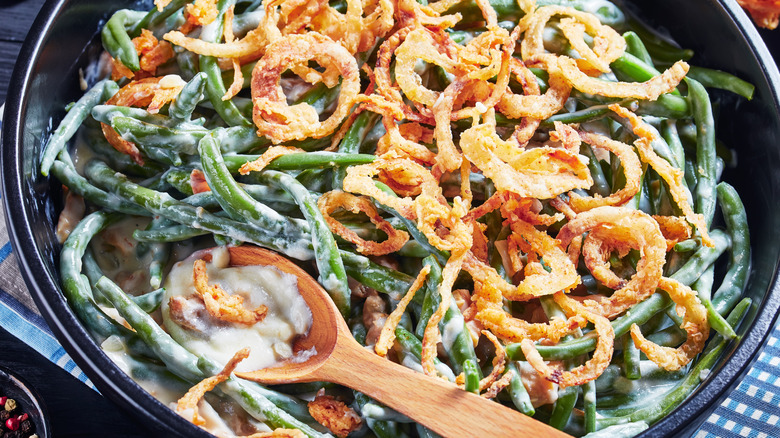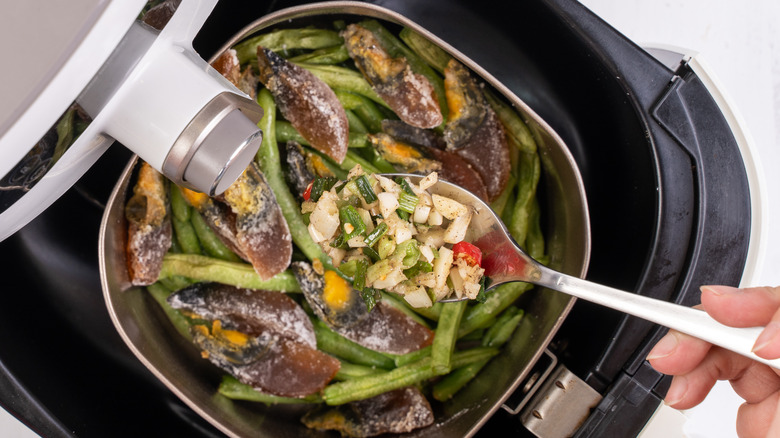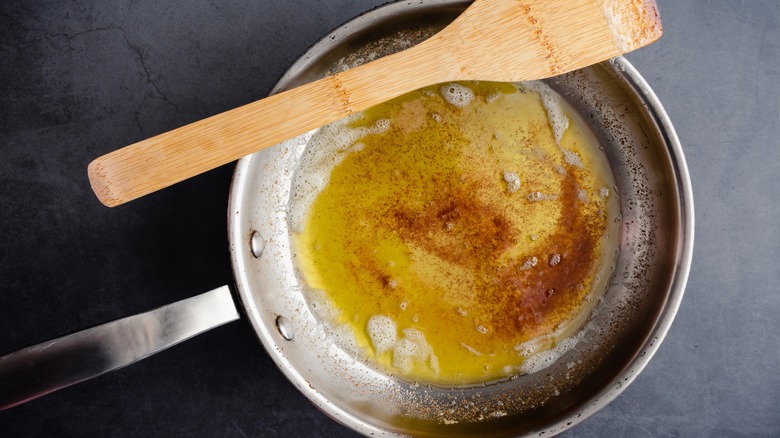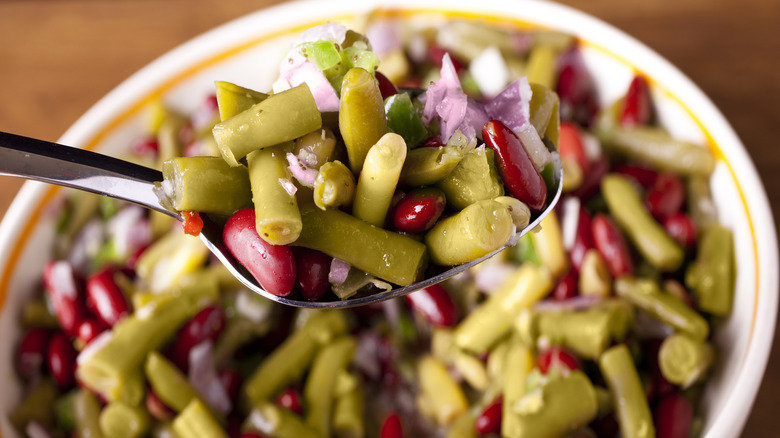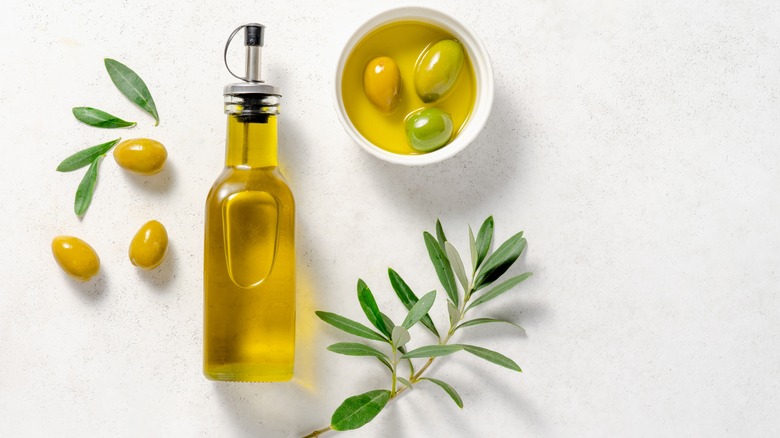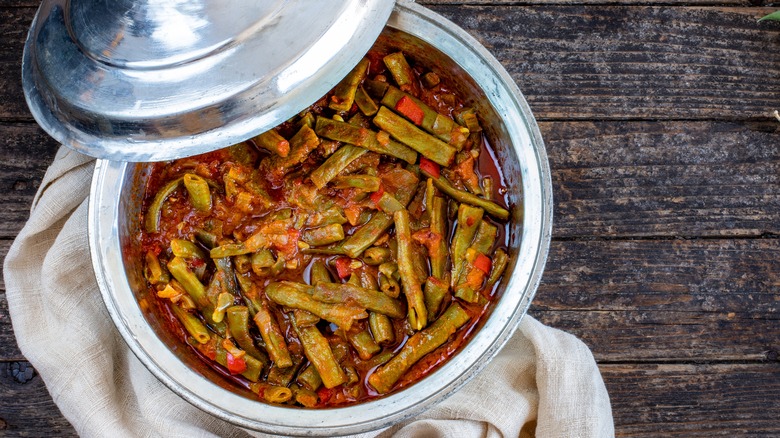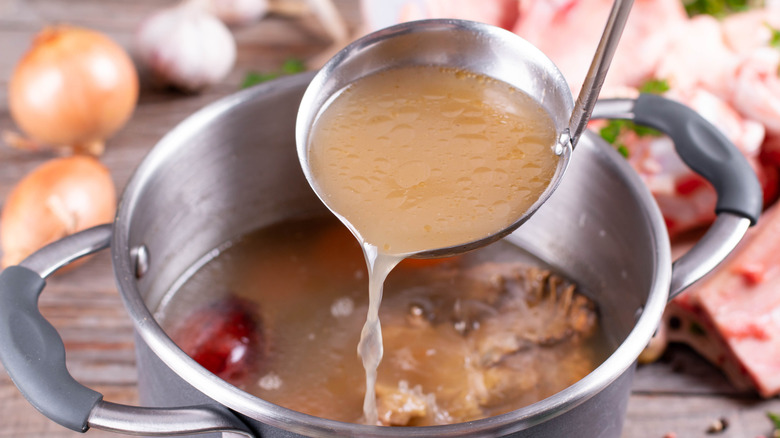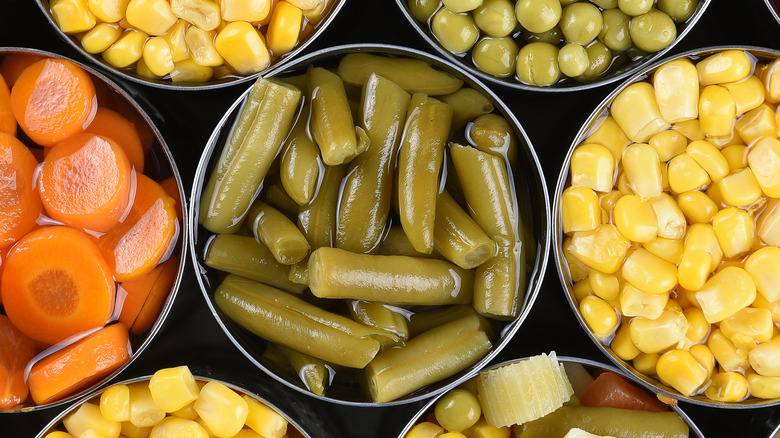12 Tips To Make Canned Green Beans Taste Better
Though canned green beans are an everyday staple in American pantries, it is not one you will often see listed as a favorite canned veggie. The reason is simple: canned green beans often attain an unappealing drab color that can be an instant turn-off. As they are processed and preserved in liquid, their texture is usually soft and mushy, which can present an issue when you want to use them in other dishes as there is a reasonable fear that they will dissipate or turn into complete mush. Lastly, but perhaps most importantly, the flavor of canned green beans is often bland, and they have trouble contributing to the dish you want to use them in.
On the other hand, canned green beans are incredibly convenient, budget-friendly, and versatile. You can instantly turn them into a filling side dish, and it would be a shame to write them off. So, we tried to think of ways to pair and process them to create a dish that would be tasty, have texture, and attain the right consistency. As it turns out, there are many options to improve the flavor of canned beans, and these are the most creative takes that will be easy to apply even to a complete culinary novice.
1. Season generously
Seasoning makes everything better, and the same applies to canned green beans. Typically, a can of green beans will only include veggies, water, and a generous amount of salt, which means you can easily play with other seasonings to give those beans an extra kick and quickly turn them into a dish that people would actually enjoy eating.
Pepper would be a great partner with canned green beans as it will give these veggies a little body, but if you want to provide even more character, add some chili flakes. Mediterranean herbs such as basil, oregano, thyme, or a classic herbes de Provence mix would also work wonderfully in combination with green beans as they share a similar vegetal note. The herbs will add more elegant aromatics. If you do not want to use fresh onions or garlic, powdered versions can easily add complexity to green beans. As it is usually soaked in sodium-packed liquid, use the salt sparingly or avoid it altogether, as the beans will soak up that saltiness.
Though it is usually easy to go overboard with adding spices to dishes, this is not the case here. The flavor of canned green beans is relatively neutral, so do not be afraid that it will clash with add-ons. Of course, use reasonable amounts and then add more after you taste it. Remember that it is much easier to add any seasoning, but it is almost impossible to strip away if it takes over the whole dish.
2. Rinse the beans before using them
Rinsing canned veggies is unnecessary, but it can significantly improve the taste of your beans. Additionally, it can also make it a tad healthier. In the canning process, most veggies, including green beans, are kept in a salty brine, so they will inevitably soak some of the salt. A reasonable amount of salt is always welcomed, but these veggies can absorb too much of it to the point of becoming unpleasant to eat. Also, incorporating these salt-packed beans into a particular dish can be problematic as it can make the whole thing unpalatable. A quick rinse can remove some of this excessive salt, and you can control the amount of added salt later in the process.
All this salt inside the can will increase the sodium level. A standard can of green beans can pack as much as 362mg, which accounts for approximately 16% of the recommended daily intake. Rinsing will not strip away all the sodium, but it can help. According to a study conducted by USDA, rinsing can reduce the sodium level by 7%. As sodium is notorious for its effect on our cardiovascular system, getting rid of even the slightest amount is certainly beneficial.
3. Cheese and cream make everything better
Perhaps the easiest way to make anything taste good is to add some cream and cheese. Cooking cream is one of the versatile ingredients that is equally loved and used in both professional and home kitchens. Adding cream to a dish will add richness and complexity. It immediately improves the texture, creating a silky, smooth emulsion that is perfect to act as a base for your green beans. Apart from the texture, the cream adds tons of flavor, so even if you do not like the taste of green beans or are working with a low-quality batch, the chances are that cream will make everything taste good, rich, and hearty.
Like cream, cheese also often acts as an MVP in the kitchen, with versatility as a bonus as you can choose the flavor and the texture of the cheese based on the recipe. In typical casseroles, green beans find a perfect partner in aged cheese; think of an authentic Italian Parmesan or a smoky cheddar. In salads, you want to pair the green beans with fresh cheese varieties. Greek feta or some flavor-packed goat cheese would be ideal, as the concentrated flavors can balance out the neutral character of green beans. Just be careful with feta. This is a very salty cheese, so rinse your beans well before mixing them in.
4. Green beans and bacon are perfect partners
Bacon is perhaps the safest thing to add to green beans to make them taste better. Regardless of how you use bacon in cooking, it is perhaps the most convenient way to add a little oomph and give the dishes that distinctive smoky depth of flavor that can't be achieved with other ingredients. The easiest way to pair canned green beans and bacon is to simmer the two in broth. The bacon will release plenty of flavor and aroma, and the green beans will pick it up, creating a fantastic, hearty medley. Rendering bacon in the pan and frying the beans in it can also do wonders for the veggies. This preparation only demands a touch of spice, and you can immediately serve it as a warm side dish.
At last, the easiest way to pair bacon and beans is to reach for the tried and tested technique used at the Texas Roadhouse. The legendary green beans recipe suggests simmering onion, green beans, and garlic in broth and finishing with crumbled fried bacon. This will not only improve the flavor, but the crispy bacon bits will also do wonders for the texture and are a perfect antidote to tender green beans.
5. Use an air fryer
It is easy to see why the air fryer has become one of the most coveted cooking gadgets in the last couple of years. Primarily, it is a much healthier option than traditional frying and is far more convenient as you can easily set the temperature and the designated cooking time. Of course, the easy cleanup and the fact it does not leave your house smelling like a bottom of a fryer are some obvious advantages. If you have been using your air fryer for some conventional ingredients such as potatoes and chicken tenders, you might be surprised to find out that you can also you this magical machine to improve the taste of canned green beans.
Rinse and drain the mix before tossing the green beans inside the air fryer. Then let it fry for around five minutes, but regularly check up on them until you get the desired texture. The beans will crisp up as they fry, but make sure not to leave them frying for too long as they might dry out. Avoid the French-style green beans for this recipe as they are thinner, and you won't be left with much after frying.
6. Use plenty of butter
Butter is one of those precious ingredients that can completely transform and improve any dish. Arguably, the best way to eat butter is to smear it on some crusty bread, but this valuable ingredient is also one of the building blocks equally important for savory and sweet dishes. It provides creaminess, moisture, and, most importantly, a lot of flavor.
Butter is the key element that can improve the taste of green beans. Try sautéing rinsed and drained green beans in butter. All that buttery richness will transform the beans into a delectable feast. You can also use it to emulsify warm sauces or cold dressings that you can later use to coat or drizzle over the beans. Also, try using just a knob of butter as a finishing touch while the beans are still warm. The butter will create a silky smooth coating and improve the overall taste. For the ultimate butter hack, try to make a batch of brown butter. This advanced butter version provides nuttiness and a completely new flavor dimension.
Remember that real butter cannot compare to margarine or other vegetable fats. As butter is a natural ingredient, it shows off these qualities even if it is later processed and used in other dishes. Anything made with vegetable fats will always be a subpar version of butter-based dishes — and the same goes for buttered green beans.
7. Go classic with three bean salad
Classic always works, and if you want to use your canned beans in a reliable and good-quality recipe, do not look further than the traditional three-bean salad. It seems that this bean combination has always been around — though it most likely originated sometime in the 1950s — and you will regularly find it gracing dinner tables at various celebrations and communal picnics. In a standard version, the salad will be made with three types of beans and usually thinly sliced onions. Typical bean combinations include green beans, kidney beans, and chickpeas, but the recipes are not set in stone, so you can always play with your favorite varieties. The ingredients are marinated in a vinaigrette-like mix, including vinegar, oil, salt, and a touch of sugar.
Though you can use frozen and fresh green beans for this salad, the easiest way is to go for canned green beans. When mixed with these firmer beans, the soft texture of green beans will not be so prominent, and the concentrated dressing will complement the relatively neutral taste of canned green beans. This combination has remained popular for a reason and could be an ideal recipe that will convince you how canned green beans can be made into a tasty dish.
8. Olive oil will easily add more depth and flavor
Olive oil has always been called liquid gold. It earned its nickname not only because of its numerous health benefits but also because of its unique flavor that has no match in the oil section. Good quality olive oil will have a complex flavor profile that will depend on several attributes, mainly freshness, origin, and the olive variety used to make it. Some of the dominant aromas and flavors in good olive oil are grassy, herbal, and sometimes even a little spicy. For the best possible variety, choose extra virgin olive oil. This least processed type truly showcases the beauty and full potential of olive oil.
Even a drizzle of olive oil over green beans will make a massive difference to your dish. Most olive oil varieties have a pronounced vegetal note that will nicely pair with the similar flavor profile found in the beans. You can shortly sauté the beans in olive oil to open up all those lovely aromas, but you can also make a classic dressing and gently toss it with warm or chilled green beans. Regardless of the preparation method, olive oil will always deliver depth and complexity, which canned green beans often call for.
9. Pair them with flavor-packed sauces
If you are still not convinced that canned green beans can make a decent dish, this idea might sway you. As the beans are somewhat bland, you can simply drench them in sauces packed with aromatic and flavorful ingredients. Your best options are soy sauce or tomato-based sauces combined with potent ingredients such as garlic, ginger, lemon juice, and aromatic herbs such as dill, basil, or cilantro.
Regional cuisines have long cracked the code of pairing green beans with statement sauces. The most obvious is the Chinese tradition, where green beans are often served doused in creative sauce combinations. They are often based on soy sauce and sometimes add honey for sweetness or chili peppers for a spicy kick. This method only calls for a sprinkle of sesame seeds that can round up the whole thing. For the Mexican-style version, combine them with tomatoes, garlic, cumin, and cilantro. A handful of chopped jalapeños will deliver some heat, which green beans always agree with.
10. A little sugar goes a long way
Sugar is a familiar baking ingredient, but if you only reserved it for desserts, this might be your cue to think more creatively and repurpose it for savory dishes. Obviously, sugar adds sweetness. This is especially useful in marinades and glazes as it aids caramelization and helps to build a delicious crispy crust on roasted meat.
But we do not only use sugar to add sweetness. In savory dishes, this kitchen staple balances all other flavors, especially if you are working with acidic elements. If you want to douse canned beans in a rich tomato sauce, just a pinch of sugar will be enough to subdue that potent tomato acidity that can sometimes take over the entire dish.
Of course, use sugar in moderation, and apply the same rule as you would to every seasoning; use small amounts and taste as you go. As sugar should not predominate, use it sparingly. Even a touch of sugar will do wonders for green beans that inherently contain sweetness while they are fresh but tend to lose it in the canning process.
11. Re-cook in stock or bouillon
Though we usually think that canned green beans are not suitable for extensive cooking as they are already processed and rather tender, there is one way a longer cooking method can improve the taste of canned green beans. You simply need to add plenty of flavor to the liquid and leave the beans inside until they soak enough of it.
The best way is to use stock, broth, or flavor the cooking water with bouillon. Stocks and broths are some of the most flavor-packed options in home kitchens, and they can easily impart the beans with enough character so they result in a tasty and enjoyable dish. Of course, you can add other seasonings and control the amount of liquid, depending on whether you want a more soupy dish or a compact mix that you can serve on the side.
Feel free to try this idea, and do not worry; contrary to popular belief, if you leave canned beans to simmer in liquid, they will not instantly turn into mush. Just rinse the beans before you use them, as you do not want any of that excessively salty canning liquid to end up in this tasty broth.
12. Choose good quality brands and always read the label
Lastly, remember that not all brands of canned beans are created equal. Do your research and choose a reliable variety or the one you believe to be most suitable for the recipe you want to make. Often, but not always, the price can be a guiding principle but do not only rely on it as a signal of quality.
Ideally, green beans will be processed and packed at their peak, meaning they will preserve most of that distinctive sweetness that fresh green beans are known for. If the producers miss this ideal margin, the younger ones may conserve more of that unpleasant vegetal character, and you certainly do not want to process over-riped beans as they will additionally soften in the can. So, if you have a brand that you trust, always go with that one. If this proves unreliable, go for the try-and-test method until you find the ideal version.
Also, read the label carefully. If you want to avoid too much sodium, pick the brands that use much less salt or those that steer clear of using additional salt.
